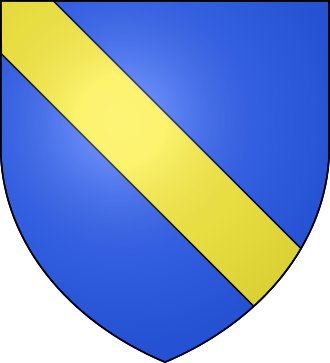Blazon





Blazon is the formal language used to describe or depict heraldic arms or coat of arms. Originating in the medieval period, blazoning has evolved over centuries to become a highly specialized language with its own vocabulary, grammar, and syntax. It serves not only as a means of identification but also as a reflection of the history, achievements, and status of the bearer.
History[edit]
The practice of heraldry began in the 12th century, primarily as a means to identify combatants in armour on the battlefield. As heraldry developed, so did the need for a standardized language to accurately and succinctly describe the complex designs on shields, banners, and other heraldic devices. This led to the creation of blazon, which has its roots in the Old French term blason, meaning "shield" or "coat of arms".
Principles[edit]
Blazoning follows a strict set of rules and conventions. The primary goal is to enable a knowledgeable reader to reconstruct the heraldic design accurately from the textual description alone. Key principles include:
- Tinctures: These are the colors and metals used in heraldry. Blazon distinguishes between metals (e.g., Or (gold) and Argent (silver)) and colors (e.g., Gules (red), Azure (blue), Vert (green), Sable (black), and Purpure (purple)).
- Ordinaries and Charges: These are the geometric shapes and symbols placed on the shield. Common ordinaries include the chief, pale, bend, fess, and chevron. Charges can be animals, objects, or other figures.
- Position and Attitude: The description often specifies the position or attitude of charges (e.g., a lion rampant, an eagle displayed).
- Complex Lines: The edges of ordinaries or divisions of the field may be straight, embattled, engrailed, indented, etc., adding to the complexity and uniqueness of the coat of arms.
Language and Syntax[edit]
Blazon uses a concise and formulaic language. The description typically starts with the field (the background of the shield) and proceeds from the most important elements to the least, following a hierarchy. Adjectives precede nouns, and the use of conjunctions is minimized. For example, a simple blazon might read: "Azure, a bend Or" – a blue field with a diagonal gold stripe.
Modern Usage[edit]
While heraldry and blazoning might seem antiquated, they remain in use in various forms around the world. Many countries, cities, universities, and families still maintain and create coats of arms, often adhering to the traditional rules of blazonry. Heraldic authorities, such as the College of Arms in England and the Court of the Lord Lyon in Scotland, continue to oversee the granting and matriculation of arms.
Conclusion[edit]
Blazon is a unique and enduring aspect of heraldic tradition, encapsulating the art and science of describing coats of arms. Its specialized language and strict conventions have allowed heraldry to remain a relevant and respected practice, linking the past with the present.
Ad. Transform your life with W8MD's Budget GLP-1 injections from $75


W8MD offers a medical weight loss program to lose weight in Philadelphia. Our physician-supervised medical weight loss provides:
- Weight loss injections in NYC (generic and brand names):
- Zepbound / Mounjaro, Wegovy / Ozempic, Saxenda
- Most insurances accepted or discounted self-pay rates. We will obtain insurance prior authorizations if needed.
- Generic GLP1 weight loss injections from $75 for the starting dose.
- Also offer prescription weight loss medications including Phentermine, Qsymia, Diethylpropion, Contrave etc.
NYC weight loss doctor appointmentsNYC weight loss doctor appointments
Start your NYC weight loss journey today at our NYC medical weight loss and Philadelphia medical weight loss clinics.
- Call 718-946-5500 to lose weight in NYC or for medical weight loss in Philadelphia 215-676-2334.
- Tags:NYC medical weight loss, Philadelphia lose weight Zepbound NYC, Budget GLP1 weight loss injections, Wegovy Philadelphia, Wegovy NYC, Philadelphia medical weight loss, Brookly weight loss and Wegovy NYC
|
WikiMD's Wellness Encyclopedia |
| Let Food Be Thy Medicine Medicine Thy Food - Hippocrates |
Medical Disclaimer: WikiMD is not a substitute for professional medical advice. The information on WikiMD is provided as an information resource only, may be incorrect, outdated or misleading, and is not to be used or relied on for any diagnostic or treatment purposes. Please consult your health care provider before making any healthcare decisions or for guidance about a specific medical condition. WikiMD expressly disclaims responsibility, and shall have no liability, for any damages, loss, injury, or liability whatsoever suffered as a result of your reliance on the information contained in this site. By visiting this site you agree to the foregoing terms and conditions, which may from time to time be changed or supplemented by WikiMD. If you do not agree to the foregoing terms and conditions, you should not enter or use this site. See full disclaimer.
Credits:Most images are courtesy of Wikimedia commons, and templates, categories Wikipedia, licensed under CC BY SA or similar.
Translate this page: - East Asian
中文,
日本,
한국어,
South Asian
हिन्दी,
தமிழ்,
తెలుగు,
Urdu,
ಕನ್ನಡ,
Southeast Asian
Indonesian,
Vietnamese,
Thai,
မြန်မာဘာသာ,
বাংলা
European
español,
Deutsch,
français,
Greek,
português do Brasil,
polski,
română,
русский,
Nederlands,
norsk,
svenska,
suomi,
Italian
Middle Eastern & African
عربى,
Turkish,
Persian,
Hebrew,
Afrikaans,
isiZulu,
Kiswahili,
Other
Bulgarian,
Hungarian,
Czech,
Swedish,
മലയാളം,
मराठी,
ਪੰਜਾਬੀ,
ગુજરાતી,
Portuguese,
Ukrainian
